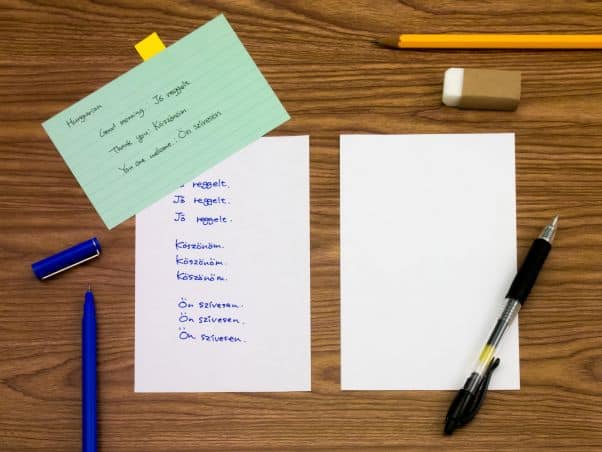Learning Hungarian could be a bit challenging, but it could also be a very rewarding experience.
Hungarian is spoken primarily in Hungary but also in Slovakia, Romania, and Serbia and has about 13 million speakers worldwide.
There are many reasons to learn Hungarian. You’re planning to tour Hungary, you enjoy Hungarian history and culture, or you just want to take on the challenge of learning Hungarian. Whatever your reasons are, having the right resources at your disposal is very important.
In this post, we share many different resources where you can learn Hungarian. We’ve tested various Hungarian resources to come up with a list of best apps, courses, podcasts, YouTube channels, and movies just for you. Let’s get started!
Table of Contents
Resources for Learning Hungarian Online
Hungarian Language Courses, Lessons, and Websites
HungarianPod101 is jam-packed with audio and video lessons, some of which are free. We wouldn’t recommend using it alone, but it’s a great supplementary course, especially if you want to improve your listening.
Mango Languages is well-suited for beginner- and intermediate-level learners. We like that it allows you to drill your pronunciation by recording yourself and playing that over the audio of the native speaker. There’s no limit to how many times you do this. You can find out more about our thoughts on it here.
Pimsleur also focuses on oral output and pronunciation. However, as Hungarian isn’t yet available as a subscription, the price is quite high. Read about our experience using Pimsleur to help you decide before you buy.
Glossika uses spaced repetition to help you memorize new words and phrases. You’ll practice speaking, listening, and writing. It has over 50 languages and you can study them simultaneously, so it could be a good option if you’re studying two or more languages at the same time. However, the curriculum is disordered and it can be buggy. Overall, we like it for intermediate-level speakers, although you’ll have to pair it with other resources to learn Hungarian grammar.
HungarianReference.com is a comprehensive English-language explanation of Hungarian grammar and pronunciation, and it even includes some basic word lists. There’s no way to drill or test yourself on the material, but it’s a great reference point or self-study checklist.
The Magyar-Tanulás Repository is a free 24-lesson grammar course. Each lesson has clear, easy-to-follow explanations in English and feels manageably bite-sized.
This Hungarian language course from Professor Aaron Rubin is designed for absolute beginners. It includes review sessions. If you can ignore the dated website appearance and focus on the content, it’s a useful introduction.
Hungarotips is another good choice for online courses, although the website’s appearance isn’t the most user-friendly. We found ourselves copying and pasting the content into Google Docs and Microsoft Word to get rid of the grainy background.
It caters to beginners through to advanced students, and combines classes with quizzes, with most of the pages suitable for beginners. You can subscribe for $22 a year to receive thrice-weekly email classes that are not posted on the website, and their 100 Common Verbs and Their Conjugation worksheet is also a handy downloadable.
Looking to improve your vocabulary? With Clozemaster, you can fill in the gaps in Hungarian sentences. We like that you can turn off the multiple-choice option to make it harder and force yourself to recall rather than merely recognize words. However, the sentences are in a random order rather than going from beginner to intermediate.
You can also use Babadum to help you practice vocabulary, although, like Clozemaster, there’s no feeling of progression. Some of the images can be hard to recognize, too: we spent a lot of time puzzling over one picture – was it a pumpkin? An onion? – only to discover the answer was “peach.”
Catch Budapest has developed a $97 Hungarian Audio Course that pairs native conversations with transcripts to help you improve your listening and vocabulary. Their website also has mini-lessons, such as this one on pronunciation training.
While slightly dated, Langmedia teaches you basic Hungarian phrases for common situations through video and audio recordings.
Mondly is a cheap-and-cheerful option for drilling beginner-level vocabulary, although we’re not convinced by the one-size-fits-all approach to the languages. The Hungarian content is identical to that for Spanish, Korean, and Urdu – even if how people typically respond in these languages is different. We also feel that the syllabus is at times illogical.
Learn101 contains several word lists and recordings that you can drill. It says it offers grammar explanations, but we found them too simplistic to be useful, and the material didn’t always seem to be logically ordered. If you use it, we recommend treating it as a series of vocabulary drills.
Transparent Language is a nicely designed course but rather pricey and surprisingly dull. It gets repetitive quickly and is based on memorization, meaning you never learn how to build sentences or say anything that isn’t in the course. We think there are better options out there for Hungarian.
17 Minute Languages claims it will teach you Hungarian in 17 minutes a day through quizzes and spaced repetition, but we were put off by its poor translations, boring exercises, and non-existent explanations.
Loecsen also left us unimpressed. On paper, it looks like a great option for drilling useful vocabulary. However, we found that too many of the phrases sounded translated and didn’t reflect how native speakers talk.
50Languages is another tool for memorizing phrases and vocabulary. With 100 free online classes, there’s plenty of content – but no explanation or grammar. We don’t believe it’s the most time-efficient or engaging way to learn Hungarian, especially since you won’t practice making your own sentences.
While not full courses, several websites and blogs will help you study specific elements of Hungarian. The Pronunciation Guide has a good breakdown of the pronunciation and you can use Hunlang’s Blog: Hungarian Grammar for Beginners to look up tricky grammar. How to Learn Hungarian has vocabulary and grammar guides on its blog, while Daily Magyar shares Hungarian learning tips and vocabulary.
Alternatively, if you’re struggling with self-study and feel you’d benefit from a tutor, take a look at iTalki, which we’ve reviewed here, and Verbling, which we’ve also reviewed before.

Learn Hungarian with these Best Apps
Memrise, Duolingo, and Drops all help you learn new words through quizzes and spaced repetition. You can also pick up some grammar from Memrise and Duolingo. While all three are similar, there are differences between them so it’s worth checking out our detailed reviews (Drops, Duolingo, Memrise) as well as our comparison of Memrise and Duolingo.
Learn Hungarian Language With Master Ling is another gamified option that works with dialogues, fill-in-the-gap exercises, flashcards, and more. However, there is no free trial option.
Alternatively, if you’re just going for a quick trip and want to memorize the important phrases, take a look at uTalk. You won’t learn any grammar or how to conjugate verbs, nor will you get the satisfaction of scoring points, but the games are highly effective at drilling words and phrases. You can also record yourself. Take a look at our review for more information.
Nemo combines a phrasebook, voice recorder, and flashcards to help you pick up the most basic words. It mostly focuses on vocabulary. While similar to uTalk, the content feels a bit lighter and easier. On the other hand, the voice recorder function makes comparing yourself to the native speaker easier.
Apple users might find the Foreign Numbers App useful. It has a fairly wide variety of games, including ones focused on math, telling the time, and listening to phone numbers.
You can add all the new words and phrases you discover to the build-your-own flashcard app Anki to practice them. We like how it adapts to the difficulty of each word. You can also use a pre-made deck, such as this one, by searching here.
The Fluent Forever Hungarian Pronunciation Trainer is an Anki-based program that will help you improve your recognition of similar Hungarian sounds. It’s particularly good for beginner and lower-intermediate learners, and it comes with a 30-day money-back guarantee. However, the Fluent Forever team has stopped providing support for it.
If you’re interested in a language exchange partner, you’ve got plenty of options. The most-used apps are HelloTalk (reviewed here), HiNative (reviewed here), Speaky (reviewed here), and Tandem (reviewed here).
You can also download the apps for many of the language courses we’ve mentioned in the last section, including HungarianPod101, Mango Languages, Pimsleur, Mondly, and 50 Languages.

Podcasts for Learning Hungarian
If you want to learn Hungarian from a podcast, you could try HungarianPod101 (which we’ve already covered under our language courses). It has a huge number of audio clips to choose from.
Another option is the One Minute Hungarian series from Radio Lingua. Some of the lessons might be slightly longer than a minute, but they’re still manageable tea-break-sized clips.
Let’s Learn Hungarian is also designed specifically for Hungarian learners. It’s not updated very often but remains popular despite that. The blog also has some interesting entries.
When you’re ready to listen to Hungarian podcasts designed for Hungarian speakers, try SBS Hungarian. It covers news, current affairs, travel, music, literature, and more. While new episodes are rare, there’s a wealth of existing ones to choose from.
Az élet, meg minden interviews a different person in every episode, ensuring not only diversity in topics but also diversity in accents. Meanwhile, the comedy show Balázsék is a popular option that will deepen your understanding of the Hungarian sense of humor.
History lovers might find Hihetetlen Történelem is the perfect way to practice their listening while also learning more about the recent past, inside and outside of Hungary.
Looking for more ideas? We’ve devoted a whole article to Hungarian podcasts.

Learn Hungarian Through YouTube and Movies
There’s no shortage of Hungarian-language videos. The newly launched Indirect Hungarian Lessons teaches beginner-level Hungarian without using any English.
Hungarize has a Daily Dose series, and they’re currently planning to add new types of videos as they get more Patreon supporters.
Ester Gottschall has content for beginners right the way through to advanced learners. Hungarian with Sziszi is an infrequently updated series English-language series that looks at beginner-level Hungarian grammar, vocabulary, and more.
Once you’re at an intermediate or advanced level, you might like to follow Hungarian vloggers.
If you’re a cinephile, try Szirmai Gergely’s channel Hollywood News Agency. He’s a popular movie critic, and if you’ve already seen the movies he’s reviewing, you’ll find these videos an accessible entry point.
When you’re ready for something a bit more challenging, take a look at Karantények. Yes, karantén is how you say quarantine in Hungarian. This project, launched in March 2020 as a response to the COVID-19 lockdowns, features several Hungarian comedians.
As for movies, Szomorú Vasárnap is a famous Hungarian film set in WWII, but that focuses more on relationships than on battles. A Viszkis tells the story of one of Hungary’s most iconic bank robbers.
The black comedy Isteni Műszak will test your ability to follow Hungarian jokes. Valami Amerika is another popular, light-hearted Hungarian film, although be warned that several of the jokes come at the US’ expense.
Looking for something higher-brow? Fehér Tenyér is a hard-hitting depiction of a man recovering from the physical abuse he experienced in Communist-era Hungary. Szabadság, Szerelem focuses on the 1956 Hungarian Revolution and is a must-watch for anyone interested in recent history.
Szaffi is a popular animated film from the ‘80s about a Romani girl denied of her inheritance. It’s set in the 1700s. The animated Macskafogó is another well-loved classic thanks to its witty satire and difficult-to-translate jokes that gently mock the Communist regime that was in power at the time.


